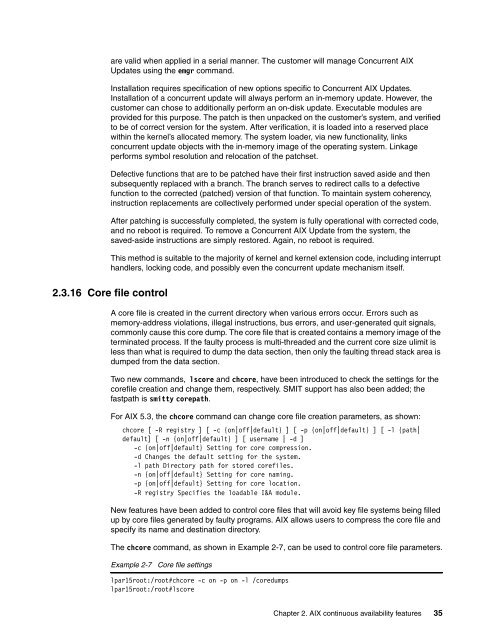IBM AIX Continuous Availability Features - IBM Redbooks
IBM AIX Continuous Availability Features - IBM Redbooks
IBM AIX Continuous Availability Features - IBM Redbooks
Create successful ePaper yourself
Turn your PDF publications into a flip-book with our unique Google optimized e-Paper software.
are valid when applied in a serial manner. The customer will manage Concurrent <strong>AIX</strong><br />
Updates using the emgr command.<br />
Installation requires specification of new options specific to Concurrent <strong>AIX</strong> Updates.<br />
Installation of a concurrent update will always perform an in-memory update. However, the<br />
customer can chose to additionally perform an on-disk update. Executable modules are<br />
provided for this purpose. The patch is then unpacked on the customer’s system, and verified<br />
to be of correct version for the system. After verification, it is loaded into a reserved place<br />
within the kernel’s allocated memory. The system loader, via new functionality, links<br />
concurrent update objects with the in-memory image of the operating system. Linkage<br />
performs symbol resolution and relocation of the patchset.<br />
Defective functions that are to be patched have their first instruction saved aside and then<br />
subsequently replaced with a branch. The branch serves to redirect calls to a defective<br />
function to the corrected (patched) version of that function. To maintain system coherency,<br />
instruction replacements are collectively performed under special operation of the system.<br />
After patching is successfully completed, the system is fully operational with corrected code,<br />
and no reboot is required. To remove a Concurrent <strong>AIX</strong> Update from the system, the<br />
saved-aside instructions are simply restored. Again, no reboot is required.<br />
This method is suitable to the majority of kernel and kernel extension code, including interrupt<br />
handlers, locking code, and possibly even the concurrent update mechanism itself.<br />
2.3.16 Core file control<br />
A core file is created in the current directory when various errors occur. Errors such as<br />
memory-address violations, illegal instructions, bus errors, and user-generated quit signals,<br />
commonly cause this core dump. The core file that is created contains a memory image of the<br />
terminated process. If the faulty process is multi-threaded and the current core size ulimit is<br />
less than what is required to dump the data section, then only the faulting thread stack area is<br />
dumped from the data section.<br />
Two new commands, lscore and chcore, have been introduced to check the settings for the<br />
corefile creation and change them, respectively. SMIT support has also been added; the<br />
fastpath is smitty corepath.<br />
For <strong>AIX</strong> 5.3, the chcore command can change core file creation parameters, as shown:<br />
chcore [ -R registry ] [ -c {on|off|default} ] [ -p {on|off|default} ] [ -l {path|<br />
default] [ -n {on|off|default} ] [ username | -d ]<br />
-c {on|off|default} Setting for core compression.<br />
-d Changes the default setting for the system.<br />
-l path Directory path for stored corefiles.<br />
-n {on|off|default} Setting for core naming.<br />
-p {on|off|default} Setting for core location.<br />
-R registry Specifies the loadable I&A module.<br />
New features have been added to control core files that will avoid key file systems being filled<br />
up by core files generated by faulty programs. <strong>AIX</strong> allows users to compress the core file and<br />
specify its name and destination directory.<br />
The chcore command, as shown in Example 2-7, can be used to control core file parameters.<br />
Example 2-7 Core file settings<br />
lpar15root:/root#chcore -c on -p on -l /coredumps<br />
lpar15root:/root#lscore<br />
Chapter 2. <strong>AIX</strong> continuous availability features 35

















